Before I move on to address the five aspects of the Better Market Street project, as presented at the recent public workshop I just overviewed, I’d like to spend some time defining a term and, while I’m at it, getting a few thoughts about Gehl Architects out of my system. As I mentioned in my last post, implementation of our new and improved Market Street isn’t going to start until 2016, so we have a bit of time to explore the subject. Not only do we have all day, we have all year and the next few after that, so bear with me.
Over the course of my recent exposure to Gehl Architects’ reading materials and presentations, I have noticed that they can be repetitive (and we all know how I feel about that). In particular, a word they repeat over and over and over again is Activate.
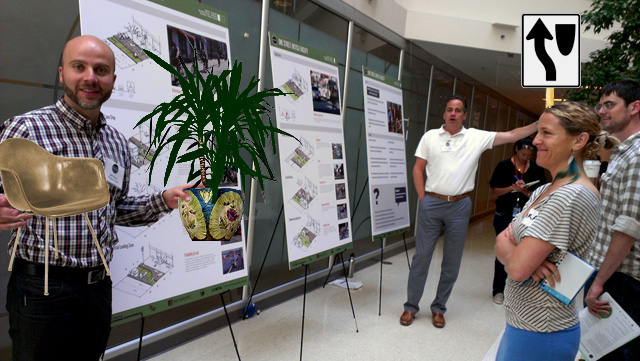
“Acteeevate!”
Says the Gehl Architect while a couple of onlookers get lost in his eyes.
Photo by me and Michael Brucker and Erich Ferdinand
Recently, I was busily cleaning my apartment, talking to myself and doing my Gehl Architect impression, when I picked up a toilet plunger and it suddenly dawned on me that I sounded a lot like a Dalek with my incessant acteeevate! chanting. Just substitute extermeeenate! for acteeevate! everywhere (s/activ/extermin/g), and I’ve got myself a Dalek impression!
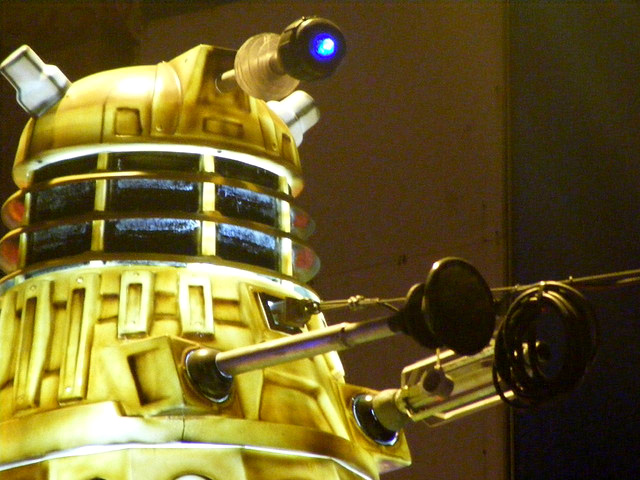
“Extermeeenate!”
Photo by kev_hickey_uk
But then I realized that this striking similarity is actually completely superficial, and Gehl Architects are in fact the total opposite of Daleks. Their familiar-sounding refrain is not mimicry but the other side of a call-and-response, a perpetual face-off between two diametrically opposed world views, but one we can only ever hear one side of, since it is volleyed through the void between dimensions. And then I got lost in a reverie and realized that what the BBC has been getting at this whole time is that Robert Moses was a spawn of the Daleks. Of course! If you want to read all about that, then by all means, stay tuned for my next post.
Anyway, as I was saying, Gehl Architects are always running around activating things. Activation, as a Gehl Architect uses the term, refers to creating a space that naturally generates activity, which is more or less measured by the number of person hours spent there. When we think of “activity” in an urban center, we often think in terms of human and vehicular throughput, as we tend to think of streets in general as commuting devices, rather than as public spaces, but activity in the Gehl Architect’s mind is not the same as throughput at all. In fact, it is only barely related and high levels of throughput can even be indicative of a failure to activate.
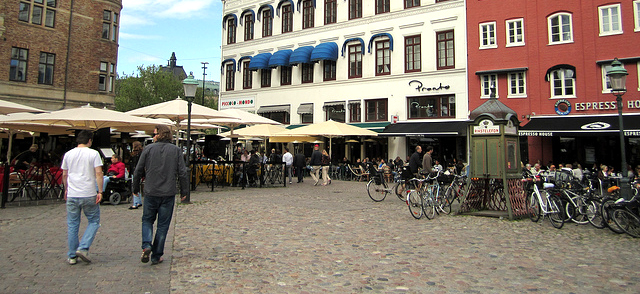
Public square in Malmö, Sweden
Photo by La Citta Vita
If you think about it in terms of person-hours rather than person feet (even if you forget to divide by 2), it’s easy to see that if 5000 people jog in one side of a town square and directly out the other, that does not create as much activity as 500 people hanging around reading books, sitting at cafés, or window shopping for 30 minutes to an hour a piece.
Many people moving quickly through the space can result in considerably less life in the city than a handful of people who spend time there…. It is generally true that the activity level in city space often increases dramatically in good weather. The difference is not that there are necessarily more people in town, but that the individual user spends more time there. We walk slower, stop more often and are tempted by offers to stay a while on benches or in cafés…. Venice has a remarkably high level of activity although the population has been reduced dramatically. The explanation is that all traffic is on foot, everyone walks slowly and there are many spontaneous stays. — Jan Gehl in Cities For People: How many and how long: quantity and quality
To me the reasons for wanting to activate a space are obvious, since an active space is by definition one humans enjoy, and being a human myself, I like the sorts of things humans like. If you need some other reasons, though, I have a few more for you:
- An active street is a source of economic vitality for the surrounding community
Of course it’s bad form to require people to spend money in order to hang around in your public space, but the good news is you don’t have to. Where there’s a bunch of people, there’s bound to be a certain percentage participating in the local economy. - A lively street feels safer, and it actually is safer too.
If you were going to mug someone, would you do it right outside a populated street cafe full of tourists taking photos? Most muggers hold off for a more romantic, secluded, clandestine opportunity.If we reinforce city life so that more people walk and spend time in common spaces, in almost every situation both real and perceived safety will increase. The presence of others indicates that a place is acceptably good and safe. There are “eyes in the street” and often “eyes on the street” as well because it has become meaningful and interesting for people in nearby buildings to follow what is going on in the street. When people make their daily rounds in city space, both the space and the people who use them becomes more meaningful and thus more important to keep an eye on and watch out for. A lively city becomes a valued city and thus also a safer city. — Jan Gehl in Cities for People: Safety and Security
- Active streets create healthier, more compact, and more sustainable cities.
It’s hard to participate in city life from inside a car. Cars aren’t very good at window shopping or gardening or sitting at cafes, so a properly activated street is always a pedestrian-dominated one. When you leave the car behind, you tend to get more exercise and interact more with other humans. You also take up less space, use up fewer non-renewable resources, and pollute less.
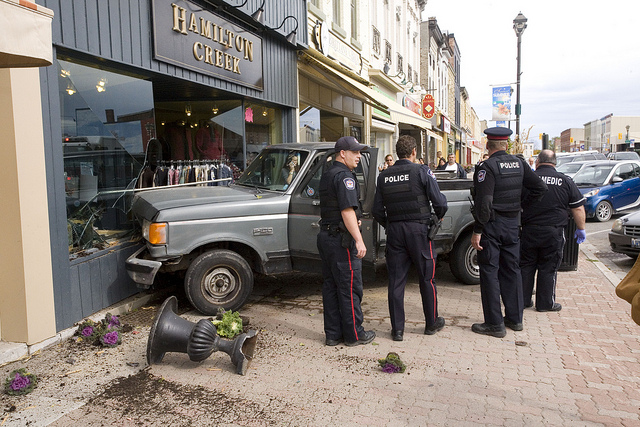
Window shopping
Photo provided by Jason Bain and The Lindsay Post, Sun Media. All rights reserved.
In order to activate a space, Gehl Architects apply a sort of urban-design Feng Shui along with a few familiar Event Planning principles to achieve the desired effect. I’ll cut to the chase, though, with some concrete examples of Dos and Donts.
In some places, all it takes to activate a space is to plunk a chair down in it.
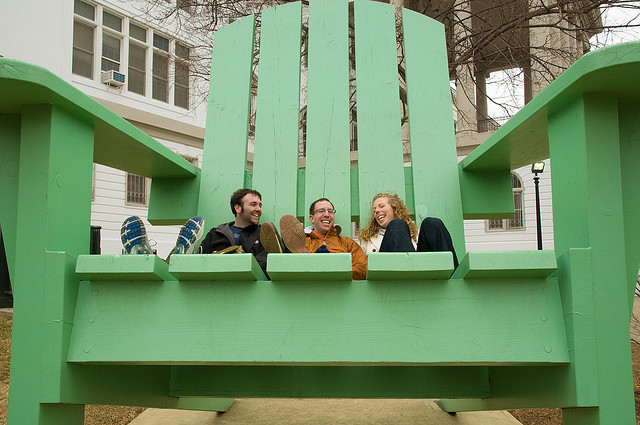
Chairs attract butts
Photo by Jared Goralnick
But while a lot of the tools and tactics for activating a space are rudimentary and accessible, urban activation is not as straightforward as it might appear. Figuring out where a chair will effectively infill a void requires a little savoir faire. In order to attract sitters, a chair must be located in a dynamic place where lots of potential sitters will walk past it. It should be near things sitters want to look at, in an atmosphere where sitters will feel safe, comfortable, and in control of their destiny.
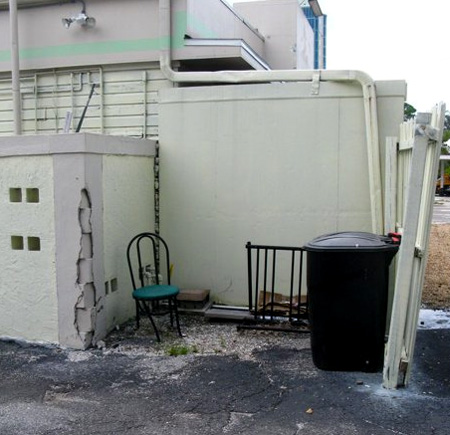
Photo by Clyde Robinson
Despite the convenient nearby bike parking, this chair isn’t going to see much action. It’s a little too hidden to be reliably discovered by potential sitters, which means it’s also too secluded to feel safe to hang around in for very long, especially after dark. And there’s nowhere to put a friend. Before we even get to the part where the occupant is going to be staring down a garbage can, this chair is a no-go.
These chairs are located in a place that probably sees a bit of traffic, and the garbage facilities in this case are well out of the way, but the chairs look uncomfortable, perhaps even designed to prevent visitors from overstaying their welcome. These token political gestures are exposed, unconfigurable, and pointed toward a dull landscape where nothing of interest ever happens.
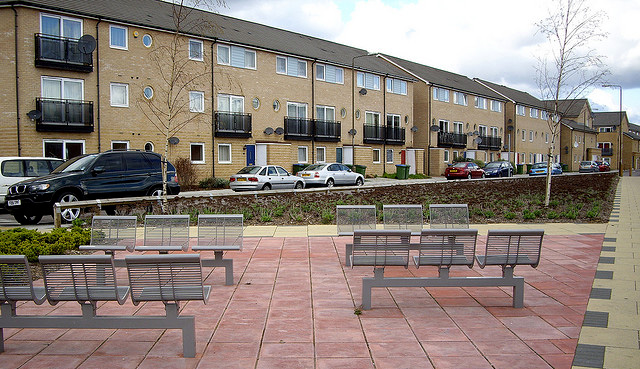
Photo by sachab
The lively living-room fixtures pictured below are unconfigurable as well, but a person’s experience in them is not. They have transcended seating to become playground equipment. They provide novelty, they’re a conversation piece, and they facilitate all kinds of different interactions among the diverse and ever-evolving constituency the surrounding area supplies.
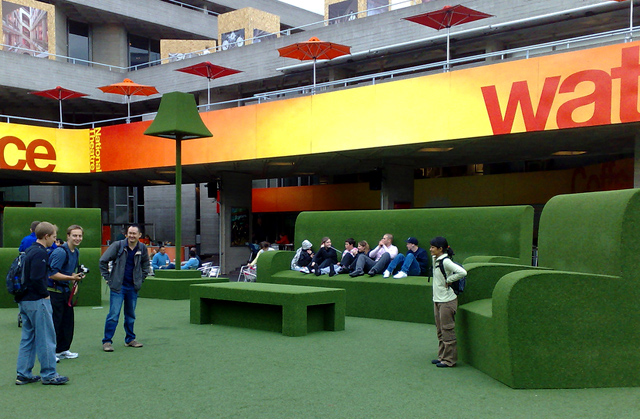
Feet on the furniture
Photo by Frankie Roberto
And then there’s the kind of activation that happens by dumb luck, or terrible misfortune, depending how you look at it.
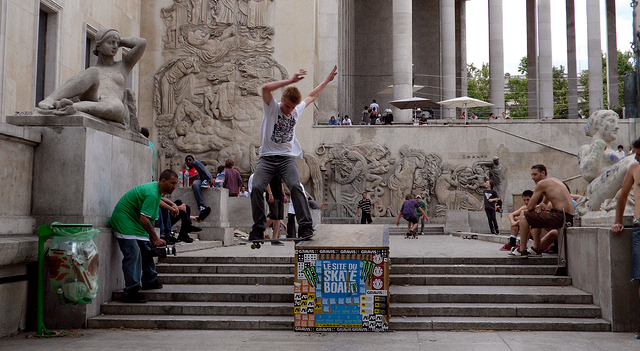
Like sugar ants to Humphry Slocombe
Photo by Addy Cameron-Huff
Skateboarders, a classic thorn in the side of architects, police, and urban planners, are ever eager to take advantage of any invitation to linger a while and interact with their surroundings, often in unanticipated ways that sometimes have unwelcome consequences.
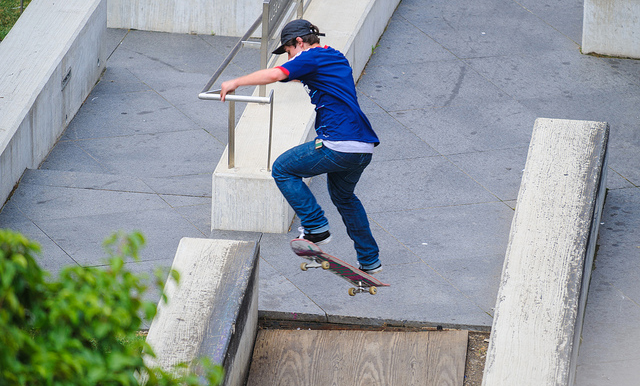
Grinding away
Photo by niXerKG
The usual countermeasure is to add deterrents or protective devices to the built environment as an afterthought, but these patches are arguably uglier than the damage they are meant to prevent or mask, and they also reduce or eliminate just the kind of liveliness we should be trying to encourage and preserve.
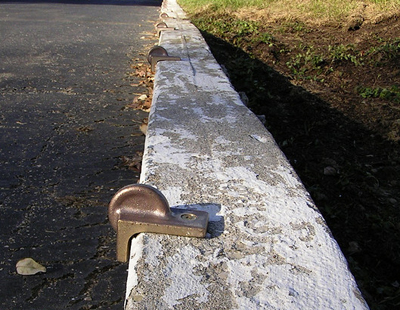
Ugly
Photo by Cindy Funk
A better approach would be to anticipate the skateboarders and provide appealing places for them to play, which can act as a release valve, redirecting rather than eliminating the energy skateboarders provide. Skateboarders have more than shown themselves to be pretty unpicky about the location of these designated areas. Historically, any centrally located seedy underpass with a bit of extra lighting will do:
[youtube]http://www.youtube.com/watch?v=290kG8Q2P2k[/youtube]
And as highway underpasses are some of the trickiest urban voids to activate, this seems to me to be a win for everyone concerned. If you really want to show your skateboarders you love them, though, give them an above ground daylighted skate park to populate, too.
Speaking of skateboard-friendly places, in the amazing not-so-distant utopian village of Portland, whole neighborhoods sometimes get together to decorate one of their intersections as an adorable exercise in “village building“. Whole big groups of strangers and their children meeting up to do urban-assault-style art together is just so Portland. It’s also another pretty good example of temporarily activating a public space, and some intersection repair projects leave behind not just paint but seating, landscaping, and other interactive elements to help keep the space activated even beyond the initial construction party.
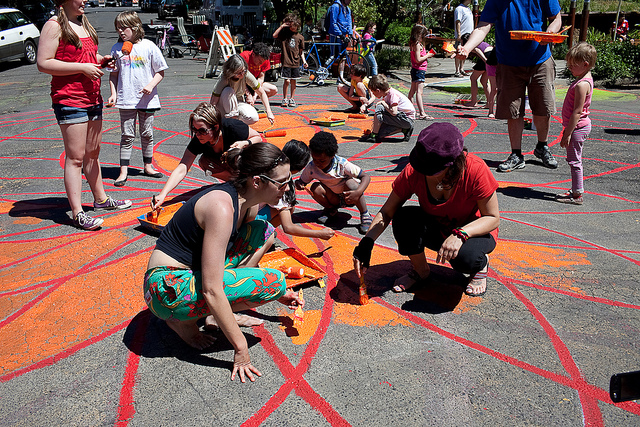
One of Portland’s famous intersection repairs in progress
Photo by Sara Dent
On an urban planning scale, if you take a part of town that already enjoys a bit of population density, and then install comfortable seating around a bit of scenery, away from cars, and amidst opportunities to watch or participate in something fun, your project stands a good chance of attracting locals and tourists on a regular basis.
This is what urban activation looks like:
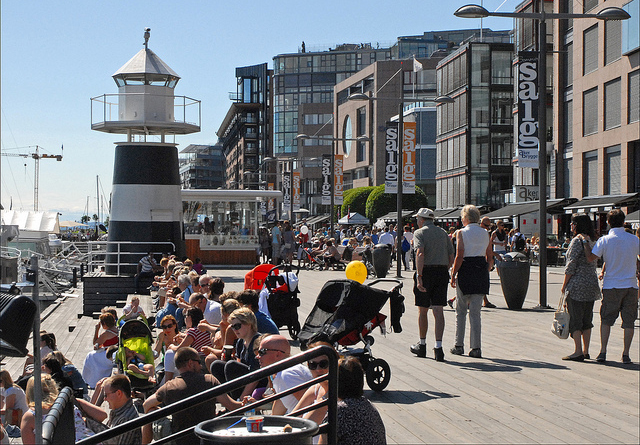
Aker Brygge, Oslo
Photo by Jean-Pierre Dalbéra
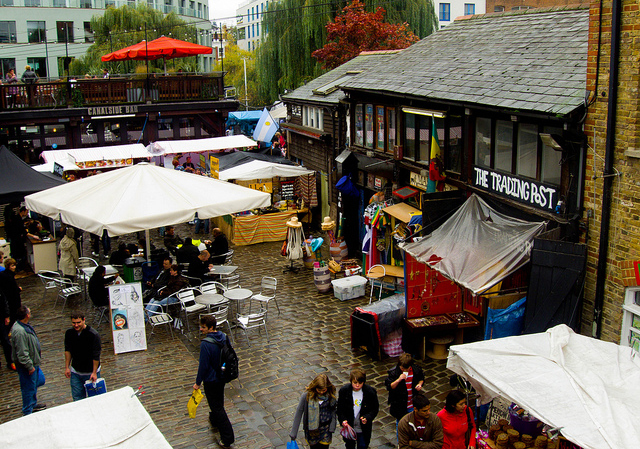
Camden Town, Middle Yard
Even on a wet day, people are out enjoying the space
Photo by Enrique Fernández
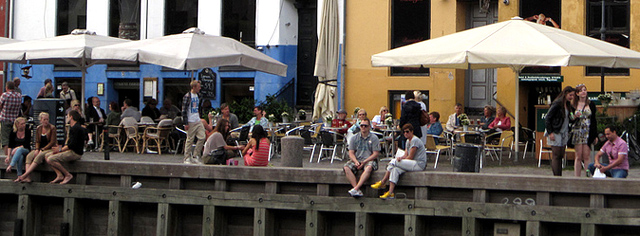
The Nyhavn waterfront district in Copenhagen invites people to take a load off
while watching the tourist boats come and go.
See? Don’t these places make you want to take a vacation and go visit them?
In an upcoming post, I’ll talk about how the Gehl Architects plan to have their way with Market Street in San Francisco so you don’t have to fly to Europe or England for this kind of experience.
Unless otherwise noted, all photos used in this post are licensed as part of the Creative Commons

A quote from District 5 Supervisorial Candidate Thea Selby’s response to the SFBC questionaire:
PS: did you know Hope Johnson supports license plates for bicycles? Hahahhahahahahahhahahhahahahhahahahahahahahastuhs;jkwh,lacr.pgtaeosuhtneuhzx
That last quote came from: http://www.sfbike.org/?vote12_d5_selby